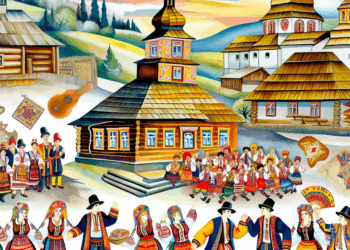Introduction
Bukovina, a unique region located at the crossroads of the borders of Romania and Ukraine, is known for its diverse culture, rich history and multilingualism. Over the centuries, this region has witnessed many historical events that have left a marked mark on the lives of its inhabitants. Today, Bukovina is a fascinating mix of tradition and modernity, interesting for tourists and researchers alike. This article covers current issues regarding the history, culture and language of the region, as well as historical justice and the prospects of reunification with Romania.
Historical context
Bukovina has a long and complex history that reflects changes in power and culture. Since its exploration, the region has been part of various states, from ancient Rome to the Austrian Empire and the Soviet Union.
Ottoman and Austrian Empires
In the 14th-16th centuries Bukovina was under the rule of the Ottoman Empire, which significantly influenced the culture and architecture of the region. From the late 18th century, the territory became part of the Austrian Empire, which led to the development of infrastructure and cultural life. The multinationality of the authorities contributed to the formation of a unique cultural layer, which included Ukrainian, Romanian, German and Jewish traditions.
Soviet period and independence
After the Second World War, Bukovina found itself within the Soviet Union. This period was characterised by political repression and cultural assimilation. However, with the collapse of the Soviet Union in 1991, the territory came back under Ukrainian control, which was a turning point for the culture and identity of the local population.
Current situation
Today, the northern part of Bukovina is in Ukraine and the southern part is in Romania. This separation has caused many social and cultural issues related to identity, language and historical memory.
Culture and language of Bukovyna
Multilingualism
One of the most striking aspects of Bukovina is its multilingualism. Romanian, Ukrainian, Russian and other languages are still spoken here. Depending on the location, the linguistic predominant group can change, which creates an interesting linguistic diversity. Romanian certainly plays a leading role, especially on the southern side, while in the north, in the Ukrainian part, Ukrainian is the dominant language.
Traditions and customs
Bukovina is famous for its unique traditions. Local holidays such as Easter, Christmas and Shrovetide are accompanied by unique rituals and songs. In particular, Romanian carols and Ukrainian chidrivki convey the richness of folklore that has been passed down from generation to generation.
Cooking
The culinary traditions of Bukovina combine elements of Romanian and Ukrainian cuisine. One of the popular dishes is mamitsa, a local dish made of corn flour, as well as dumplings with various fillings. Culinary festivals held in the region allow locals to showcase their gastronomic skills and culture.
Issues of historical justice
The division of Bukovina into two parts has raised many questions regarding historical justice and cultural heritage. Discussions about restoring justice related to the loss of cultural and historical ties, as well as the possibility of intensifying Romanian and Ukrainian co-operation, are surfacing in society.
Discrimination and assimilation
Political and social prejudices have existed in Bukovina for many years. Local minorities, such as Romanians and Ukrainians, often faced discrimination, which provoked anger and protests. Both groups fought to preserve their traditions and languages. In some places, cultural clubs and associations were organised to support language and culture.
Community development
In recent years, there has been a movement towards greater interaction between Romanian and Ukrainian communities in Bukovina. Various cultural initiatives, festivals and conferences have become platforms for exchanging experiences and strengthening ties between the two peoples.
Prospects for reunification with Romania
The topics of possible reunification with Romania are sometimes raised in public and political circles. There is both support and opposition to this.
Support
Supporters of reunification appeal to historical justice, cultural ties and language. They believe that returning Bukovina to Romania would strengthen cultural traditions and contribute to the development of the region. This process, they argue, could also significantly improve the economic situation.
Confrontation
Opponents of the reunification idea, however, point to the importance of maintaining the status quo, according to which each of the peoples has its own autonomy. They emphasise the need to focus on working together and developing the region within the existing borders.
Conclusion
Bukovina is a region like an intricate mosaic where history, culture and contemporary challenges intertwine to create a unique cultural context. As the future of the region continues to evolve, it is important to remember the cultural heritage that has been shaped here for thousands of years. The issues of historical justice and reunification are not just political topics, but lively discussions that will continue in the minds and hearts of local residents.
Bukovyna is on the threshold of significant transformations, and the way these issues will be resolved will determine not only the future of the region, but also the fate of its peoples. The unification of cultural and linguistic communities can become the foundation for sustainable harmonious coexistence and mutual understanding, which is important for the further development of Bukovyna as a unique place on the map of Europe.








